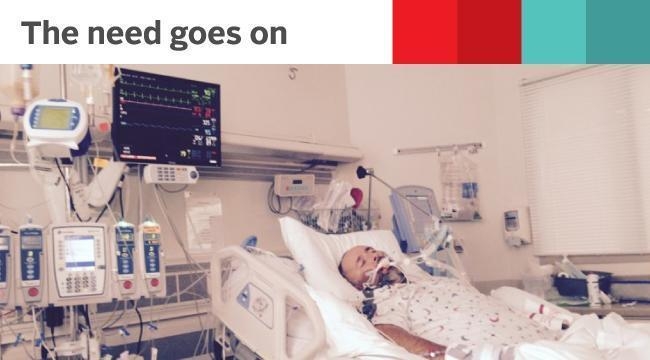Living with sickle cell disease and educating others
Ulysse Guerrier, who relies on blood transfusions, is raising awareness of both his illness and the need for diverse donors
Sickle cell disease is a debilitating condition that affects approximately 5,000 Canadians. The disease is caused by an inherited mutation in hemoglobin, a protein in red blood cells that carries oxygen to the body's organs and tissues and transports carbon dioxide back to the lungs. While normal red blood cells are soft, round, and can squeeze through tiny blood vessels, people with sickle cell disease have red blood cells that contain mostly hemoglobin S, an abnormal hemoglobin type. These red blood cells are stiff and distorted, with a sickle-like shape, and they sometimes block small blood vessels.
Sickle cell disease is inherited, and blood donations are crucial for treatment
When sickle cell disease runs in a family, members may inherit the disease itself or sickle cell trait (which means they have inherited the gene from one of their parents). Anyone can have sickle cell disease or the trait, but it is seen more frequently in people from Africa, the Mediterranean, the Caribbean, the Middle East, the Western Pacific Region, South America, and Central America.
Individuals with sickle cell disease are affected in two ways: the breakdown of their red blood cells (hemolysis) and the blockage of blood flow in their blood vessels (vaso-occlusion). Together, these cause serious complications including severe pain, respiratory problems, organ failure and even stroke. Sickle cell disease is not contagious and there is no widely used cure. Treatment of complications of sickle cell disease often includes antibiotics, pain management, intravenous fluids, blood transfusion, and surgery.
For many patients who need regular blood transfusions, a close blood type match is essential. Red blood cells have proteins on their surface called antigens. There are more than 600 known antigens, with more being discovered each year, and a person’s unique combination of antigens is called their “phenotype.” Since a person’s detailed blood type (beyond ABO blood group) is linked to ancestry, a close match may only be found in donors of the same race or similar ethnicity. The Sickle Cell Disease Association of Canada has been raising awareness of the importance of “phenotyped” blood in the treatment of sickle cell disease. Blood that has been phenotyped has been assessed for its particular profile of antigens, which are proteins found on the surface of each red blood cell.
How we help patients with rare blood
This September, Canadian Blood Services is proud to support the Sickle Cell Disease Association of Canada in observing Sickle Cell Awareness Month, by bringing attention to both the challenges of living with this disease and the vital role of blood donors in treatment.
Ulysse is here today thanks to the support of blood donors. He and thousands of other sickle cell patients in Canada rely on regular blood transfusions to manage this difficult, lifelong disorder.
Ulysse Guerrier was born in Toronto in 1976, after his parents immigrated from Haiti in the early 1970s. Four of the family’s five children were diagnosed with sickle cell disease. Two of them have since passed away. At two years old, Ulysse was diagnosed with Sickle Cell S Beta Thalassemia, a type of sickle cell disease that is associated with beta thalassemia, a blood disorder that reduces the production of hemoglobin.
“Before I was born, my sister passed away when she was six months old,” shared Ulysse. “When I was a baby, my mother was very protective of me because she recognized some of the signs she saw in my sister. The symptoms were swelling of the hands and feet, crying often for no apparent reason, jaundice of the eyes and colic that had no clear diagnosis.”
“When I was two years old, I got sick when my family was on vacation Haiti. My parents took me to a doctor who ultimately diagnosed me with sickle cell disease, a disease that is common in Haiti and other Caribbean and African countries.”
Sickle cell pain management
After his diagnosis, Ulysse and his family were introduced to various forms of pain management. His treatment began with narcotics for the pain, and over the years has included a variety of drugs such as codeine, Tylenol 3, morphine, and various opioids including Demerol. Extended use of these drugs produced reactions which resulted in a need to seek out other options.
Demerol helped Ulysse with the pain, but its accumulation in his body caused severe side effects including multiple seizures. He says his search for effective, sustainable pain management continues.
“The last drug I can tolerate, and am taking right now, is Fentanyl. Unfortunately, this drug is the poster child for the opioid crisis. So even though it works for a lot of people with sickle cell, including me, its bad reputation means some patients have a difficult time getting access.”
Donated blood in the treatment of sickle cell disease
Blood and blood products have played a key role in Ulysse’s treatment over the years. He has had an average of two units of blood per month since he was ten. He currently receives monthly red cell exchanges, where his own red blood cells are replaced with cells from donors. The disease and its treatment have both taken a toll on him. Even though the red cell exchanges are essential, they tend to leave him feeling drained and with pain in the spinal area. His bones have also been damaged over the years.
“After years of living with sickle cell disease, I have developed AVN (Avascular necrosis) in my shoulders and my hips due to the diminished blood flow to my bones. I had a hip replacement in 2005.”
Over the years, treatment for sickle cell disease has evolved and life expectancy has increased. In the 1970’s, people with sickle cell disease rarely lived beyond age ten, but today, many patients with the disease are living into their 60’s.
Becoming an advocate
Ulysse and his family were first introduced to sickle cell disease as a diagnosis in Haiti by Dr. Yvette Bonny. This well-known hematologist continued to play a significant role in his life after she immigrated to Canada when he was ten.
“Growing up with the disease, I thought I was the only one,” he shared. “After I met Dr. Bonny, she helped me to see that there were others. Even though there are more of us, not too many are comfortable talking about illness and the issues they face.”
“She became a role model for me and has influenced the work I do as a sickle cell advocate in Canada and around the world.”
Ulysse spent time as a camp counselor and board member of the Canadian Sickle Cell Society. After moving to Toronto in his twenties, he joined the Sickle Cell Association of Ontario, and became a coordinator of the sickle cell program at TAIBU Community Health Centre ― the first program of its kind in the Toronto area, to provide specialized primary care for adults with sickle cell.
Ulysse also started a YouTube Channel called Our Sickle Cell Life to talk about how this disease affects people’s daily lives and the different challenges that they face.
Reducing the stigma of sickle cell disease
Asked what he would most like others to know about sickle cell disease, Ulysse shared this:
“It’s not a Black person’s disease, it’s a red blood cell disorder. As long as you have blood going through your veins, there is a possibility that you could carry the gene. It is very important for people to know their status.
“Regardless of your background, there is a chance that you might carry the gene. In 2021, there is no excuse for not knowing that you have the gene. It’s a simple blood test.”
In the community, Ulysse’s objective is to increase awareness of the disease.
“I want the state of sickle cell disease to improve during my time in this world. To eradicate the stigma we face. This includes things like the way the treatment is given, the way they treat people in the hospital, the racism that we face and the perception of us being ‘drug seekers.’”
Blood donors with the same ethnic background as the patient with sickle cell disease are the best source of lifesaving blood for transfusions to treat them. As a person who continues to live with the disease, Ulysse encourages eligible Canadians to donate blood.
“There are a lot of people like me who need blood. Right now, I need seven to twelve units of blood every four weeks. I have been receiving blood since I was 10, so over 25 years I have probably received more than 10,000 units, and that’s just me.”
Ulysse also wants people to understand the importance of a diverse donor base.
“It’s very important to have a bigger pool of diverse donors. It’s only when things hit close to home that it becomes important to you. You shouldn’t wait for a tragedy to make the decision to help.”
We encourage members of diverse communities to support people in Canada with sickle cell disease by donating blood and joining Canadian Blood Services Stem Cell Registry. Blood donors and stem cell registrants can also show their support for these patients by joining the Sickle Cell Disease Association of Canada’s Partners for Life team.



